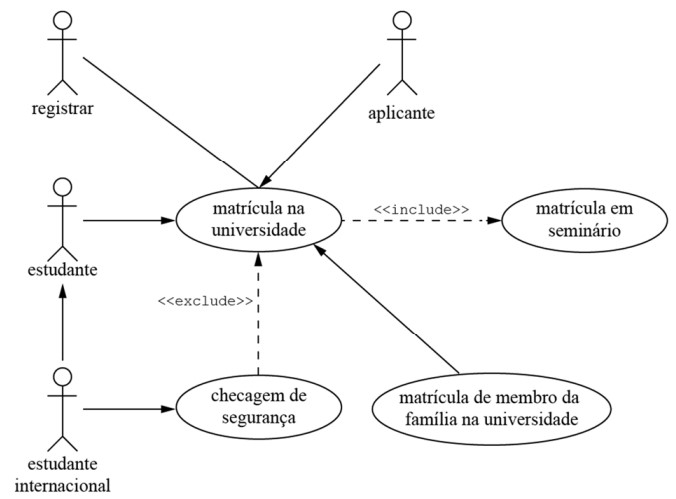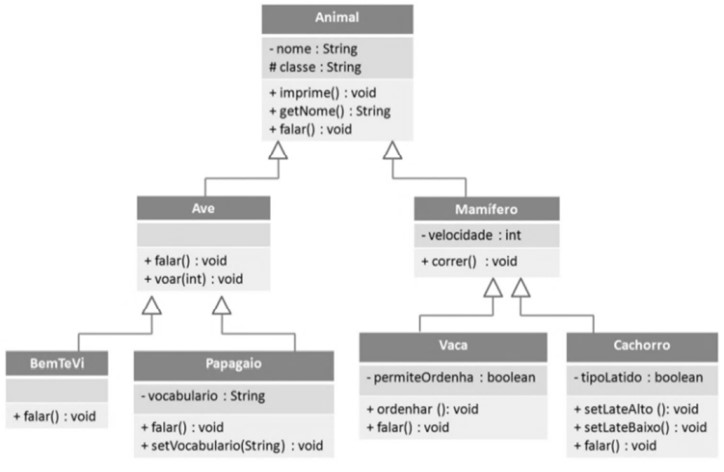Questões da prova:
Cebraspe (cespe) - 2025 - BDMG - Analista de Desenvolvimento
limpar filtros
120 Questões de concurso encontradas
Página 15 de 24
Questões por página:
Questões por página:
Concurso:
BDMG
Disciplina:
Engenharia de Software
Julgue o próximo item, acerca de análise de requisitos, UML e conceitos relativos à orientação a objetos.
No diagrama de caso de uso apresentado a seguir, o ator estudante internacional herda do ator estudante, e, ao se acionar o caso de uso matrícula em seminário, o caso de uso matrícula na universidade é obrigatoriamente acionado.

Concurso:
BDMG
Disciplina:
Engenharia de Software
Julgue o próximo item, acerca de análise de requisitos, UML e conceitos relativos à orientação a objetos.
No seguinte diagrama de classes, os métodos e atributos das classes Ave e Mamífero são herdados da classe Animal e o método falar(), nas classes BemTeVi, Papagaio, Vaca e Cachorro, é um exemplo de polimorfismo.

Innovation is crucial for the food industry to address several critical challenges. Firstly, it is essential to meet the rising demand for food products driven by a growing global population. By implementing new technologies and improving production processes, companies can significantly increase output. Secondly, innovation plays a vital role in enhancing the efficiency and reducing the costs associated with food production. This allows companies to remain competitive by offering affordable prices while maintaining profitability. Finally, innovation empowers companies to adapt to evolving consumer preferences. This includes developing new products that cater to specific dietary needs and preferences, such as healthier options or products with unique flavor combinations.
Innovation in the food industry can be broadly categorized into four key areas: product innovation, process innovation, packaging innovation, and marketing/branding innovation. Product innovation focuses on creating new or improved food products with unique features and benefits for consumers. This may involve developing new flavors, textures, and incorporating healthier ingredients. Process innovation aims to optimize production processes by implementing new technologies and methods to increase output while maintaining or improving quality standards. Packaging innovation explores innovative ways to package and present food products to consumers, such as using eco-friendly materials, implementing unique designs, and incorporating features that extend shelf life. Finally, marketing/branding innovation involves developing creative strategies to promote food products to consumers, leveraging social media, influencer marketing, and engaging campaigns to build brand loyalty.
Internet: <tastewise.io> (adapted).
Based on the text above, judge the following item.
Process innovation in the food industry primarily focuses on developing new and unique flavors for food products.
Innovation in the food industry can be broadly categorized into four key areas: product innovation, process innovation, packaging innovation, and marketing/branding innovation. Product innovation focuses on creating new or improved food products with unique features and benefits for consumers. This may involve developing new flavors, textures, and incorporating healthier ingredients. Process innovation aims to optimize production processes by implementing new technologies and methods to increase output while maintaining or improving quality standards. Packaging innovation explores innovative ways to package and present food products to consumers, such as using eco-friendly materials, implementing unique designs, and incorporating features that extend shelf life. Finally, marketing/branding innovation involves developing creative strategies to promote food products to consumers, leveraging social media, influencer marketing, and engaging campaigns to build brand loyalty.
Internet: <tastewise.io> (adapted).
Based on the text above, judge the following item.
Process innovation in the food industry primarily focuses on developing new and unique flavors for food products.
Innovation is crucial for the food industry to address several critical challenges. Firstly, it is essential to meet the rising demand for food products driven by a growing global population. By implementing new technologies and improving production processes, companies can significantly increase output. Secondly, innovation plays a vital role in enhancing the efficiency and reducing the costs associated with food production. This allows companies to remain competitive by offering affordable prices while maintaining profitability. Finally, innovation empowers companies to adapt to evolving consumer preferences. This includes developing new products that cater to specific dietary needs and preferences, such as healthier options or products with unique flavor combinations.
Innovation in the food industry can be broadly categorized into four key areas: product innovation, process innovation, packaging innovation, and marketing/branding innovation. Product innovation focuses on creating new or improved food products with unique features and benefits for consumers. This may involve developing new flavors, textures, and incorporating healthier ingredients. Process innovation aims to optimize production processes by implementing new technologies and methods to increase output while maintaining or improving quality standards. Packaging innovation explores innovative ways to package and present food products to consumers, such as using eco-friendly materials, implementing unique designs, and incorporating features that extend shelf life. Finally, marketing/branding innovation involves developing creative strategies to promote food products to consumers, leveraging social media, influencer marketing, and engaging campaigns to build brand loyalty.
Internet: <tastewise.io> (adapted).
Based on the text above, judge the following item.
The primary motivation behind innovation in the food industry is to cater to the increasing demand for organic food products.
Innovation in the food industry can be broadly categorized into four key areas: product innovation, process innovation, packaging innovation, and marketing/branding innovation. Product innovation focuses on creating new or improved food products with unique features and benefits for consumers. This may involve developing new flavors, textures, and incorporating healthier ingredients. Process innovation aims to optimize production processes by implementing new technologies and methods to increase output while maintaining or improving quality standards. Packaging innovation explores innovative ways to package and present food products to consumers, such as using eco-friendly materials, implementing unique designs, and incorporating features that extend shelf life. Finally, marketing/branding innovation involves developing creative strategies to promote food products to consumers, leveraging social media, influencer marketing, and engaging campaigns to build brand loyalty.
Internet: <tastewise.io> (adapted).
Based on the text above, judge the following item.
The primary motivation behind innovation in the food industry is to cater to the increasing demand for organic food products.
Innovation is crucial for the food industry to address several critical challenges. Firstly, it is essential to meet the rising demand for food products driven by a growing global population. By implementing new technologies and improving production processes, companies can significantly increase output. Secondly, innovation plays a vital role in enhancing the efficiency and reducing the costs associated with food production. This allows companies to remain competitive by offering affordable prices while maintaining profitability. Finally, innovation empowers companies to adapt to evolving consumer preferences. This includes developing new products that cater to specific dietary needs and preferences, such as healthier options or products with unique flavor combinations.
Innovation in the food industry can be broadly categorized into four key areas: product innovation, process innovation, packaging innovation, and marketing/branding innovation. Product innovation focuses on creating new or improved food products with unique features and benefits for consumers. This may involve developing new flavors, textures, and incorporating healthier ingredients. Process innovation aims to optimize production processes by implementing new technologies and methods to increase output while maintaining or improving quality standards. Packaging innovation explores innovative ways to package and present food products to consumers, such as using eco-friendly materials, implementing unique designs, and incorporating features that extend shelf life. Finally, marketing/branding innovation involves developing creative strategies to promote food products to consumers, leveraging social media, influencer marketing, and engaging campaigns to build brand loyalty.
Internet: <tastewise.io> (adapted).
Based on the text above, judge the following item.
The word “leveraging” as used in the second paragraph implies the act of taking as much advantage or profit as possible from something.
Innovation in the food industry can be broadly categorized into four key areas: product innovation, process innovation, packaging innovation, and marketing/branding innovation. Product innovation focuses on creating new or improved food products with unique features and benefits for consumers. This may involve developing new flavors, textures, and incorporating healthier ingredients. Process innovation aims to optimize production processes by implementing new technologies and methods to increase output while maintaining or improving quality standards. Packaging innovation explores innovative ways to package and present food products to consumers, such as using eco-friendly materials, implementing unique designs, and incorporating features that extend shelf life. Finally, marketing/branding innovation involves developing creative strategies to promote food products to consumers, leveraging social media, influencer marketing, and engaging campaigns to build brand loyalty.
Internet: <tastewise.io> (adapted).
Based on the text above, judge the following item.
The word “leveraging” as used in the second paragraph implies the act of taking as much advantage or profit as possible from something.